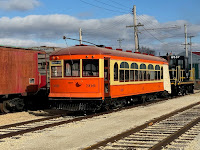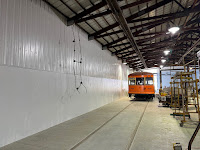Sunday was a beautiful day to be out at the museum, sunny and with a high around 50. It was a great day for a switch move, and when I arrived, one was already well underway.
Now that is a beautiful sight! This was the first time I'd seen the 306 outdoors since it was painted, and boy, did it look great.The purpose of the switching was twofold: first, to move the 306 onto the pit to facilitate wiring work underneath the car; and second, to put CRT 1268 into the "Tim Peters berth" at the west end of track 42, while the 1808 was moved one berth east to the "roof booth." The 1808 doesn't need any more roof work, I don't think, but this just puts it and the 1268 next to each other.
As part of this switching, Cleveland PCC 4223, shown here, was moved one berth west and is now at the northwest corner of Barn 4. The restoration of this car is moving along slowly; I believe they're working on running wiring through the floor troughs.
I also ambled up to the depot and took a photo of our newest acquisition, Milwaukee Road "Buffeteria" 126. Read all about it here. You can sort-of make them out over the near end of the car in this image, but it's got these nifty smoke ventilators with fins on top so that they rotate like a weathervane and always point in the trailing direction regardless of which way the car is going. That may be common on passenger cars, but it's not something I'd noticed before.
Anyway, back to Barn 4. Here we see the 306 deposited on the pit, while alongside, you can see the barn skin that contractors installed on the north wall of Barn 4 on Saturday. This really makes the barn look more modern, or professional, or something. At least until it gets all dirty and cluttered.
As for me, my first priority was to get my four windows for the 18 sanded smooth and then primed. Voila. With help from Zach and Richard, I also retrieved some repro advertising cards from storage and put them in the 18's ad card racks, so that makes the interior look slightly better. And Good Nick and Matthew helped move the spare seat cushions for the 18 to the seat cushion storage area.
The switch move featured IT 1565 doing some of the switching, which was the first time in a few years I'd seen it motoring, ever since it went out of service with faulty contactors. That's exciting! Zach was working on bottle valves while Richard was working on the new display of historic rail that he's building over in Barn 8.
After dinner, I conned Nick and Matthew, shown above, into helping a little on the 63. The what now, you ask? Well, the 63 is a Shaker Heights PCC originally built for Minneapolis that IRM acquired from Trolleyville back in 2009. Long term, the car needs a lot of steel work, but for the moment it's complete and in pretty good mechanical/electrical shape. It ran at IRM briefly around a decade ago until its MG set failed. A new MG set is now on hand, and the hope is to install that under the car and get it running again, possibly this year.
I have volunteered to improve the car's appearance by painting it - not its "forever" paint job, that can wait until the aforementioned steel work gets done, but a roller job similar to what I did on Kansas City 755 some 20 years ago. And for the paint scheme, we've picked this livery, which the car wore from around 1974-1975 until about 1980-1981. It's a brilliant reddish-orange with a grey roof, ivory belt rail stripe, and maroon pinstriping. The livery is accurate for the car as it is currently outfitted, with full-height windows in the doors and a "gumball" light on the roof but no pantograph.
Anyway, all that said, Nick and Matthew went over to the car to help find a paint sample. And we lucked out - Nick discovered that the insides of the battery box doors still wear a nearly untouched coat of 1970s red-orange, which I've been calling "vermilion." So, they removed the door (in the top photo, Nick is running the screwdriver while Matthew sheds some light on things) and we brought it into the shop, as you can see. The next step will be to get this paint matched, then in the spring and summer I can spot-prime the car as needed and begin painting. Interested in supporting this effort? Every bit helps!
I have volunteered to improve the car's appearance by painting it - not its "forever" paint job, that can wait until the aforementioned steel work gets done, but a roller job similar to what I did on Kansas City 755 some 20 years ago. And for the paint scheme, we've picked this livery, which the car wore from around 1974-1975 until about 1980-1981. It's a brilliant reddish-orange with a grey roof, ivory belt rail stripe, and maroon pinstriping. The livery is accurate for the car as it is currently outfitted, with full-height windows in the doors and a "gumball" light on the roof but no pantograph.
Anyway, all that said, Nick and Matthew went over to the car to help find a paint sample. And we lucked out - Nick discovered that the insides of the battery box doors still wear a nearly untouched coat of 1970s red-orange, which I've been calling "vermilion." So, they removed the door (in the top photo, Nick is running the screwdriver while Matthew sheds some light on things) and we brought it into the shop, as you can see. The next step will be to get this paint matched, then in the spring and summer I can spot-prime the car as needed and begin painting. Interested in supporting this effort? Every bit helps!








The 306 certainly looks great! All the guys who have been working on this project deserve a lot of credit for their years of effort. And I can't wait to get a couple of the Chicago cars posed next to it for pictures!
ReplyDeleteI also think that "TERMINAL LOCAL" is pretty hilarious as a destination. You may never come back.